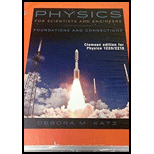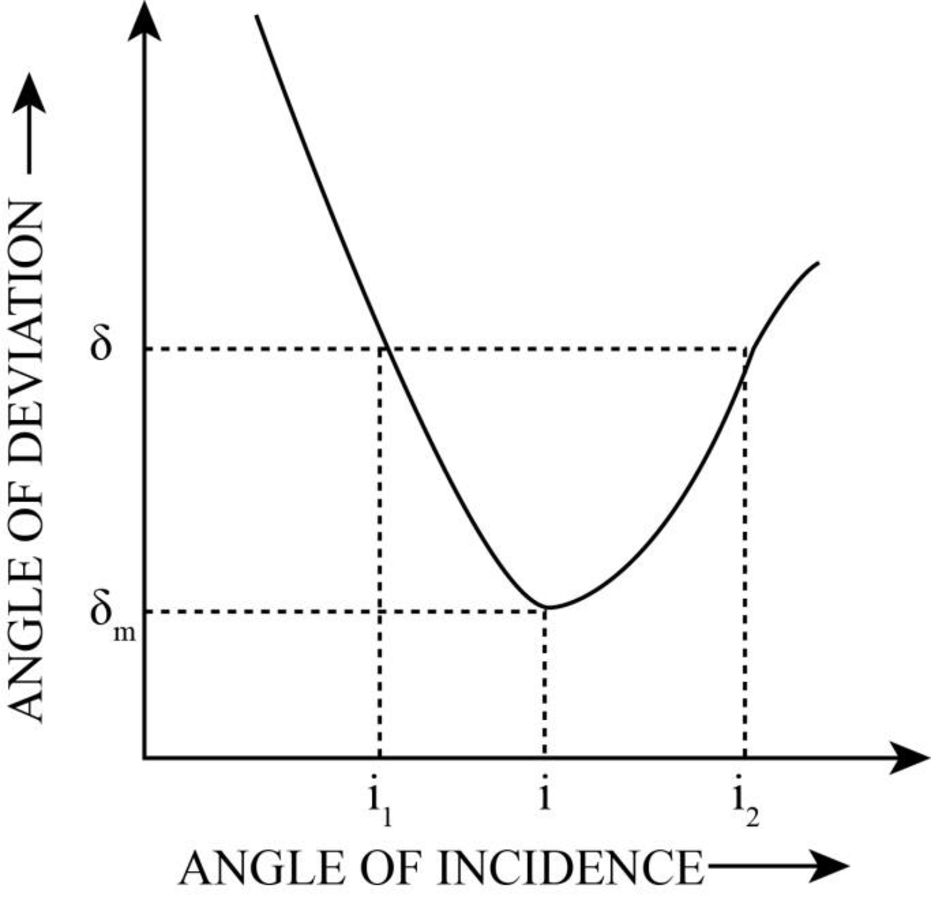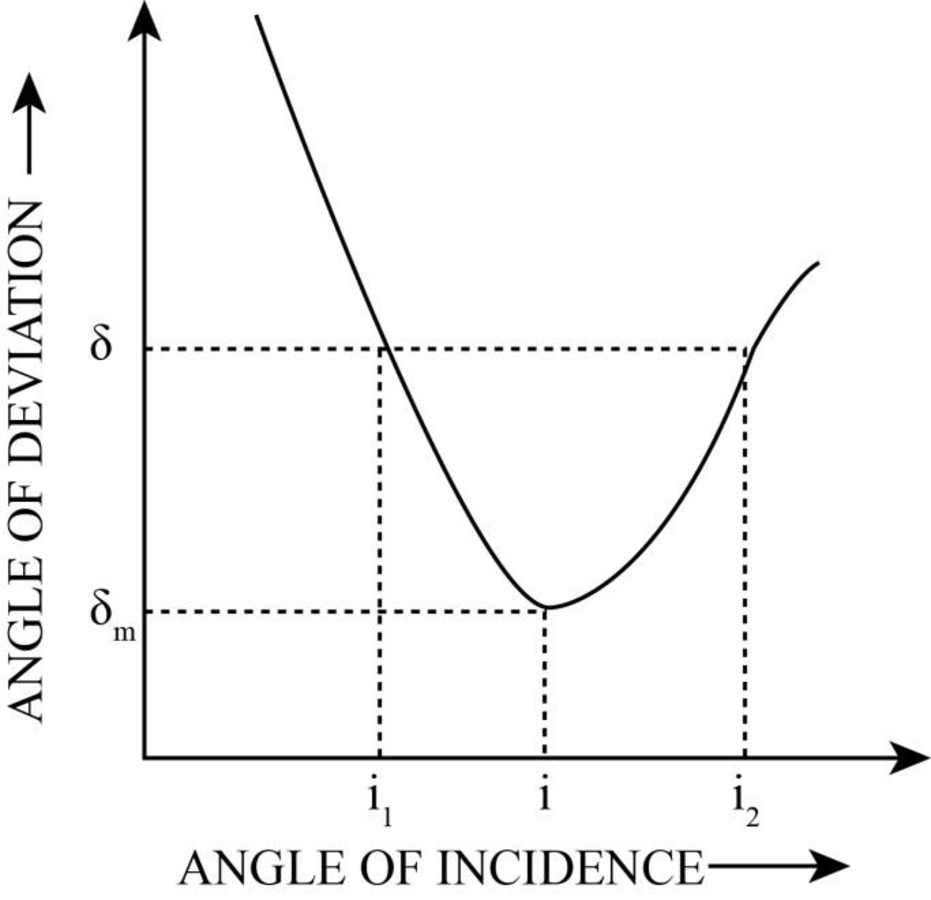
Concept explainers
(a)
The proof that total deviation of a ray from its original path is
(a)
Answer to Problem 124PQ
The total deviation of a ray from its original path is
Explanation of Solution
Write the expression for refraction law at left side of the given prism.
Here,
Write the expression for refraction law at right side of the given prism.
Here,
Write the expression angle of deviation of the given prism.
Here,
Write the relation among various angle from the geometry of the prism.
Substitute
Further solve this for
Use general trigonometric relation for conversion.
Substitute
Substitute
Substitute
Conclusion:
Therefore, it is proved that the angle of deviation is
(b)
The plot of the angle of deviation versus the angle of incidence for
(b)
Answer to Problem 124PQ
The graph is following.

Explanation of Solution
Write the expression for the angle of deviation of the given prism.
Conclusion:
Substitute
Deviation varies linearly, decreases and then increases approximately with incidence angle
Therefore, the plot of the angle of deviation versus the angle of incidence is as follows.

Figure-(1)
(c)
The incidence angle for which the derivation angle is minimum.
(c)
Answer to Problem 124PQ
The incidence angle for which deviation is minimum is
Explanation of Solution
The minimum deviation occurs when the incident and the refracted ray are identical and make equal angles to the normal of the prism.
The angle exhibits a minimum at
Conclusion:
The minimum angle of deviation depends on the refractive index for different wavelength, the refractive index is different.
Want to see more full solutions like this?
Chapter 38 Solutions
Physics for Scientists and Engineers: Foundations and Connections
- (a) For a spherical capacitor with inner radius a and outer radius b, we have the following for the capacitance. ab C = k₂(b- a) 0.0695 m 0.145 m (8.99 × 10º N · m²/c²)( [0.145 m- 0.0695 m × 10-11 F = PF IIarrow_forwardA pendulum bob A (0.5 kg) is given an initialspeed of vA = 4 m/s when the chord ishorizontal. It then hits a stationary block B (1kg) which then slides to a maximum distanced before it stops. Determine the value of d.The coefficient of static friction between theblock and the plane is μk = 0.2. The coefficientof restitution between A and B is e = 0.8.Ans: d=1.0034 marrow_forwardFigure 29-43 Problem 12. ••13 In Fig. 29-44, point P₁ is at distance R = 13.1 cm on the perpendicular bisector of a straight wire of length L = 18.0 cm carrying current i = 58.2 mA. (Note that the wire is not long.) What is the magnitude of the magnetic field at P₁ due to i? P2° R R Larrow_forward
- Checkpoint 1 The figure shows the current i in a single-loop circuit with a battery B and a resistance R (and wires of neg- ligible resistance). (a) Should the emf arrow at B be drawn pointing leftward or rightward? At points a, B C R b, and c, rank (b) the magnitude of the current, (c) the electric potential, and (d) the electric potential energy of the charge carriers, greatest first.arrow_forwardPls help ASAParrow_forwardPls help asaparrow_forward
 Physics for Scientists and EngineersPhysicsISBN:9781337553278Author:Raymond A. Serway, John W. JewettPublisher:Cengage Learning
Physics for Scientists and EngineersPhysicsISBN:9781337553278Author:Raymond A. Serway, John W. JewettPublisher:Cengage Learning Physics for Scientists and Engineers with Modern ...PhysicsISBN:9781337553292Author:Raymond A. Serway, John W. JewettPublisher:Cengage Learning
Physics for Scientists and Engineers with Modern ...PhysicsISBN:9781337553292Author:Raymond A. Serway, John W. JewettPublisher:Cengage Learning College PhysicsPhysicsISBN:9781305952300Author:Raymond A. Serway, Chris VuillePublisher:Cengage Learning
College PhysicsPhysicsISBN:9781305952300Author:Raymond A. Serway, Chris VuillePublisher:Cengage Learning Principles of Physics: A Calculus-Based TextPhysicsISBN:9781133104261Author:Raymond A. Serway, John W. JewettPublisher:Cengage Learning
Principles of Physics: A Calculus-Based TextPhysicsISBN:9781133104261Author:Raymond A. Serway, John W. JewettPublisher:Cengage Learning Physics for Scientists and Engineers: Foundations...PhysicsISBN:9781133939146Author:Katz, Debora M.Publisher:Cengage Learning
Physics for Scientists and Engineers: Foundations...PhysicsISBN:9781133939146Author:Katz, Debora M.Publisher:Cengage Learning College PhysicsPhysicsISBN:9781285737027Author:Raymond A. Serway, Chris VuillePublisher:Cengage Learning
College PhysicsPhysicsISBN:9781285737027Author:Raymond A. Serway, Chris VuillePublisher:Cengage Learning





